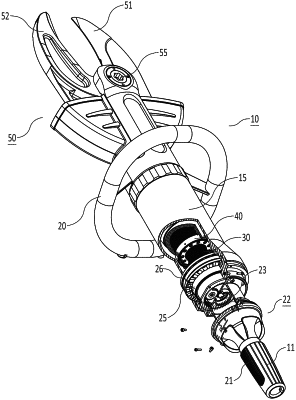| CPC A62B 3/005 (2013.01) [B23D 29/00 (2013.01); F16H 1/28 (2013.01); F16H 25/2252 (2013.01); F16H 57/10 (2013.01); B23D 7/04 (2013.01); F16H 2025/2075 (2013.01); F16H 2025/2084 (2013.01)] | 11 Claims |

|
1. Rescue tool comprising a drive system which is provided inside a housing and which is configured and suitable for actuating a linear displacement of an implement drive member,
wherein the drive system is connected for axial rotation to a rotation shaft of an energizable drive source,
wherein the rotation shaft of the drive source is coupled for force transmission to an axially rotatable spindle,
wherein the spindle is coupled rotatably to the housing by means of an axial bearing assembly,
wherein a linearly movable drive body is coupled for force transmission to the spindle and is configured and suitable for converting an axial rotation of the spindle to a linear translation of the drive body,
wherein the drive body is coupled for force transmission to the implement drive member,
wherein said axial bearing assembly comprises a first bearing flange adjacent to the spindle and a second bearing flange substantially parallel relative to the first bearing flange and wherein rotatable elements are received between the first bearing flange and the second bearing flange, such that in operation axially transmitted forces from the spindle are absorbed by said axial bearing,
wherein the drive body comprises a planetary roller of a planetary roller-spindle mechanism, which planetary roller is suspended for axial rotation in rolling contact with the spindle and is arranged over the spindle,
wherein a hollow drive rod is provided which extends on a first side in force-transmitting manner from the drive body and is coupled, or at least can be coupled, on a second, opposite side in force-transmitting manner to the implement drive member,
wherein the drive rod and the drive body lie coaxially around the spindle and at least substantially fully enclose the spindle in a retracted position of the drive rod,
wherein the rotation shaft of the drive source is coupled for force transmission to the spindle via a mechanical reduction transmission,
wherein the mechanical reduction transmission comprises at least one planetary gear mechanism,
wherein a central driven gear in the mechanical reduction transmission engages on at least one planet gear arranged there around,
wherein said spindle lies substantially co-axial with said rotation shaft of said drive source,
wherein said mechanical reduction transmission is coupled rotatably to said axial bearing assembly,
wherein said drive source comprises at least a first energizable motor to drive the central driven gear of the planetary gear mechanism of the mechanical reduction transmission and having a first transmission ratio relative to said spindle, and a second energizable motor to drive an outer ring gear of the planetary gear mechanism of the mechanical reduction transmission and having a second transmission ratio relative to said spindle,
wherein said first transmission ratio is different from said second transmission ratio;
wherein the second energizable motor is to drive the outer ring gear in a same direction as the first energizable motor drives the central driven gear, so as to increase an output speed of the planetary gear mechanism and a corresponding output speed of the spindle; and
wherein in operation the second energizable motor is controlled to drive the outer ring gear until resistance from the output mechanical reduction transmission causes the second energizable motor to be overloaded and then mechanically or electronically uncoupled, while operation of the tool proceeds by the first energizable motor driving the central driven gear of the planetary gear mechanism of the mechanical reduction transmission.
|